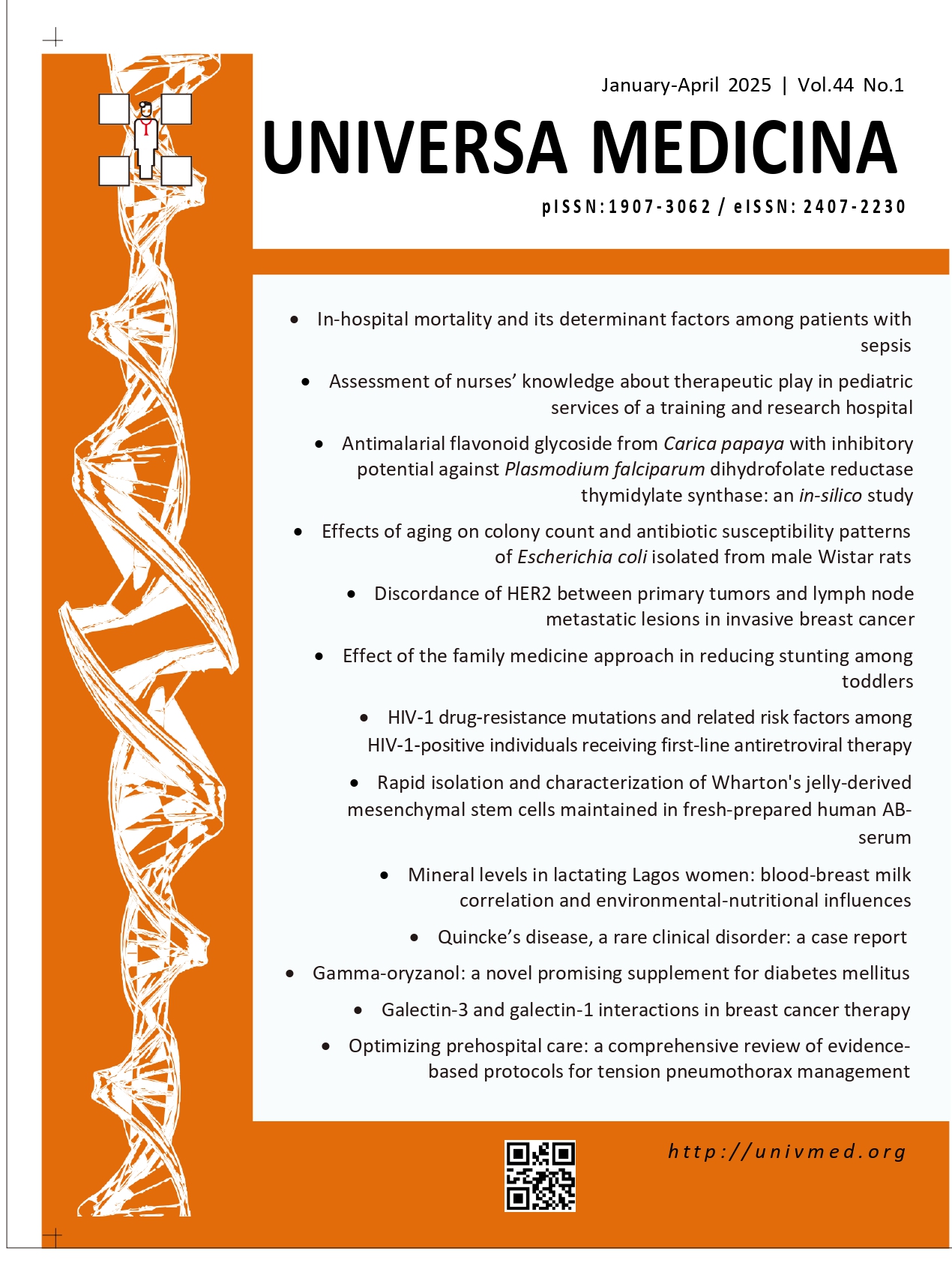Rapid isolation and characterization of Wharton's jelly-derived mesenchymal stem cells maintained in fresh-prepared human AB-serum
Main Article Content
Abstract
Background
Mesenchymal stem cells (MSCs) are valued in regenerative medicine for their multipotency, proliferative capacity, and immunomodulatory properties. Wharton’s jelly-derived MSCs (WJ-MSCs) from the umbilical cord offer a non-invasive, promising source for clinical applications, because easy isolation, lack of ethical concerns, and the presence of both embryonic and adult stem cells have made them a valuable source for use in therapeutic applications and regenerative medicine. This study aimed to optimize WJ-MSC isolation and characterization methods.
Methods
Human umbilical cords from three healthy donors were collected post-cesarean under strict inclusion criteria. WJ-MSCs were isolated using the explant culture method, with cells adhering to T75 flasks pre-coated with 2% gelatin. Cultures were maintained in Dulbecco’s Modified Eagle Medium (DMEM) supplemented with 10% freshly prepared Human AB serum and monitored for 21 days. Flow cytometry (BD FACSAria) was performed at passages 1 and 5 to assess MSC markers CD105, CD73, CD90, and CD44, alongside the exclusion marker CD45.
Results
WJ-MSCs exhibited fibroblast-like morphology by passage 1 and showed robust proliferation. Flow cytometry revealed high CD44 expression (~60%) at passage 1, while CD105, CD73, and CD90 became prominent by passage 5. CD45 remained low, suggesting minimal hematopoietic contamination.
Conclusion
This study confirms the feasibility of isolating and expanding WJ-MSCs using DMEM with 10% human AB serum. While consistent cell growth was achieved, the 21-day culture period may require optimization for scalability, including serum concentration, substrate coatings, and oxygen levels. CPJ-MSCs may be preferable for applications demanding rapid expansion and early marker expression.
Article Details
Issue
Section

This work is licensed under a Creative Commons Attribution-NonCommercial-ShareAlike 4.0 International License.
The journal allows the authors to hold the copyright without restrictions and allow the authors to retain publishing rights without restrictions.
How to Cite
References
1. Rajabzadeh N, Fathi E, Farahzadi R. Stem cell-based regenerative medicine. Stem Cell Investig 2019;6:19. doi: 10.21037/sci.2019.06.04.
2. Huynh PD, Tran QX, Nguyen ST, Nguyen VQ, Vu NB. Mesenchymal stem cell therapy for wound healing: an update to 2022. Biomed Res Ther 2022;9:5437–49. https://doi.org/10.15419/ bmrat.v9i12.782.
3. Kauer J, Schwartz K, Tandler C, et al. CD105 (endoglin) as negative prognostic factor in AML. Sci Rep 2019;9:1–11. https://doi.org/10.1038/ s41598-019-54767-x.
4. Xia C, Yin S, To KKW, Fu L. CD39/CD73/A2AR pathway and cancer immunotherapy. Mol Cancer 2023;22:44. https://doi.org/10.1186/s12943-023-01733-x.
5. Chen S, Wainwright DA, Wu JD, et al. CD73: An emerging checkpoint for cancer immunotherapy. Immunotherapy 2019;11:983–97. https://doi.org/ 10.2217/imt-2018-0200.
6. Mattheolabakis G, Milane L, Singh A, Amiji MM. Hyaluronic acid targeting of CD44 for cancer therapy: from receptor biology to nanomedicine. J Drug Target 2015;23:605–18. https://doi.org/ 10.3109/1061186X.2015.105207.
7. Ghaneialvar H, Soltani L, Rahmani HR, Lotfi AS, Soleimani M. Characterization and classification of mesenchymal stem cells in several species using surface markers for cell therapy purposes. Indian J Clin Biochem 2018;33:46–52. https://doi.org/10.1007/s12291-017-0641-x.
8. He H, Nagamura-Inoue T, Takahashi A, et al. Immunosuppressive properties of Wharton’s jelly-derived mesenchymal stromal cells in vitro. Int J Hematol 2015;102:368–78. https://doi.org/ 10.1007/s12185-015-1844-7.
9. Kamal MM, Kassem DH. Therapeutic potential of Wharton’s jelly mesenchymal stem cells for diabetes: achievements and challenges. Front Cell Dev Biol 2020;8:16. https://doi.org/10.3389/ fcell.2020.00016.
10. Ranjbaran H, Abediankenari S, Mohammadi M, et al. Wharton’s jelly derived-mesenchymal stem cells: Isolation and characterization. Acta Med Iran 2018;56:28–33. https://doi.org/10.1111/ cpr.21904.
11. Cardoso TC, Ferrari HF, Garcia AF, et al. Isolation and characterization of Wharton’s jelly-derived multipotent mesenchymal stromal cells obtained from bovine umbilical cord and maintained in a defined serum-free three-dimensional system. BMC Biotechnol 2012;12:1–11. https://doi.org/10.1186/1472-6750-12-18.
12. Abouelnaga H, El-Khateeb D, Moemen Y, El-Fert A, Elgazzar M, Khal A. Characterization of mesenchymal stem cells isolated from Wharton’s jelly of the human umbilical cord. Egypt Liver J 2022;12:2. https://doi.org/10.1186/s43066-021-00165-w.
13. Beeravolu N, McKee C, Alamri A, et al. Isolation and characterization of mesenchymal stromal cells from human umbilical cord and fetal placenta. J Vis Exp 2017;2017:1–13. https://doi.org/10.3791/55224.
14. Todtenhaupt P, Franken LA, Groene SG, et al. A robust and standardized method to isolate and expand mesenchymal stromal cells from human umbilical cord. Cytotherapy 2023;25:1057–68. https://doi.org/10.1016/j.jcyt.2023.07.004.
15. Hendijani F. Explant culture: An advantageous method for isolation of mesenchymal stem cells from human tissues. Cell Prolif 2017;50:1–14. https://doi.org/10.1111/cpr.12334.
16. Pham H, Tonai R, Wu M, Birtolo C, Chen M. CD73, CD90, CD105 and cadherin-11 RT-PCR screening for mesenchymal stem cells from cryopreserved human cord tissue. Int J Stem Cells 2018;11:26–38. https://doi.org/10.15283/ijsc17015.
17. Suyama T, Takemoto Y, Miyauchi H, Kato Y, Matsuzaki Y, Kato R. Morphology-based noninvasive early prediction of serial-passage potency enhances the selection of clone-derived high-potency cell bank from mesenchymal stem cells. Inflamm Regen 2022;42:1–13. https://doi.org/10.1186/s41232-022-00214-w.
18. Niknam B, Azizsoltani A, Heidari N, et al. A simple high yield technique for isolation of Wharton’s jelly-derived mesenchymal stem cell. Avicenna J Med Biotechnol 2024;16:95–103. https://doi.org/10.18502/ajmb.v16i2.14860.
19. Zheng S, Gao Y, Chen K, Liu Y, Xia N, Fang F. A robust and highly efficient approach for isolation of mesenchymal stem cells from Wharton’s jelly for tissue repair. Cell Transplant 2022;31:9636897221084354. doi: 10.1177/ 09636897221084354.
20. Bharti D, Shivakumar SB, Park JK, et al. Comparative analysis of human Wharton’s jelly mesenchymal stem cells derived from different parts of the same umbilical cord. Cell Tissue Res 2018;372:51–65. https://doi.org/10.1007/s00441-017-2699-4.
21. Cao Y, Boss AL, Bolam SM, et al. In vitro cell surface marker expression on mesenchymal stem cell cultures does not reflect their ex vivo phenotype. Stem Cell Rev Reports 2024;20: 1656–66. https://doi.org/10.1007/s12015-024-10743-1.
22. Bodiou V, Kumar AA, Massarelli E, van Haaften T, Post MJ, Mousatsou P. Attachment promoting compounds significantly enhance cell proliferation and purity of bovine satellite cells grown on microcarriers in the absence of serum. Front Bioeng Biotechnol 2024;12:1443914.. https://doi.org/10.3389/fbioe.2024.1443914.
23. Moniz I, Ramalho-Santos J, Branco AF. Differential oxygen exposure modulates mesenchymal stem cell metabolism and proliferation through mTOR signaling. Int J Mol Sci 2022;23:3749. doi: 10.3390/ijms23073749.
24. Kasten A, Naser T, Brüllhoff K, et al. Guidance of mesenchymal stem cells on fibronectin structured hydrogel films. PLoS One 2014;9: e109411. doi: 10.1371/journal.pone.0109411.


